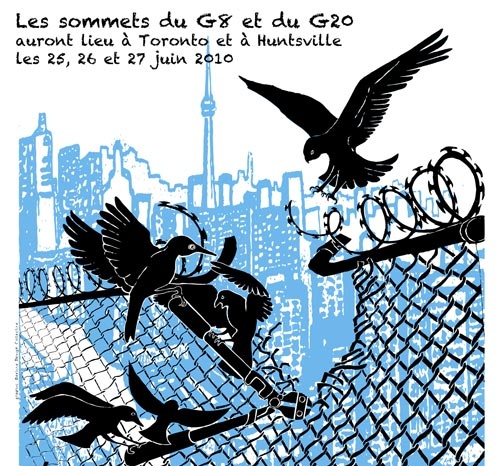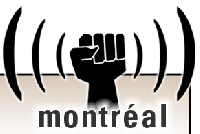 |
 |
 |
 |
 |
 |
|
 |
 |
 |
 |
 |
 |
 |
Régions du Québec |  |
 |
 |
|
 |
 |
|
 |
 |
|
 |
 |
 |
 |
 |
 |
Rubriques (sujets) |  |
 |
 |
|
 |
 |
|
 |
|
 |
 |
 |
My testimonial on the anti-FTAA demonstrations: What I saw and felt.
Volunteering as a street medic at the protests in Quebec I got to see a lot of things I had hoped to never ever be exposed to. I wrote this article to help myself heal, and to let the world know what really went on and was not reported in the mainstream media. I welcome any comments or questions.
I want to write about what I saw this weekend in Quebec City. I volunteered as a Street Medic for the anti-FTAA protests, from Wednesday afternoon until Sunday afternoon. In the course of these days I saw so much that I hope to never see again. I treated hundreds of injured people, got tear gassed, felt the effects of pepper spray, and mostly felt the kind of turmoil that a peaceful society ought not to experience.
Throughout the event medics were targeted by the police: wherever my partner and I would be treating people, tear gas canisters would land right beside us. Some medics got hit with rubber bullets. On Friday, my friend Sean was on his knees treating a patient in a tear gas cloud on the front lines, when a canister fell right under his face and exploded. He inhaled so much of it right there, then he tried to stumble to his feet only to narrowly miss a canister aimed at his head. Another canister hit the wall behind him, bounced and hit him in the back, knocking him flat. A final canister rolled by his face again and exploded. He was rescued by another medic team and spent the next two days recuperating in the medic clinic on Cote D’Abraham.
On the front lines on Friday we began treating people as the gassing began. We kept having to retreat more and more to avoid the clouds of gas. At one point a canister exploded right next to me. I can’t begin to explain the agony of being hit head on with tear gas first of all it suffocates you. I began to walk very quickly, barely restraining the panic, as I coughed and choked. I thought I would die, that any minute my asthma would kick in. Everywhere we turned there were more riot cops, more gas, and no safe space to calm down and decompress. My eyes were fine, being sealed under swim goggles, but my skin was burning like fire. Finally we managed to find a corner without gas and I got my breath back. I can’t explain the fear that set in afterwards I was so scared to go anywhere near the cops. But I was in Quebec to do a service treat injured people who were in pain. Now that I knew what that pain was like, I also knew I had to go back into the fray. As we walked back into the chaos, we came upon a girl who had been hit by a canister of gas, which exploded all over her body. Medics were treating her by stripping off her clothing and pouring liquids all over her. The poor girl was crying and screaming, in so much pain. Around us were clouds and clouds of gas, and cops advancing on all sides. The cops began shooting canisters high into the air, into the back of the crowd, where we were. In that area were only peaceful protesters; we were not up by the perimeter fence, and we were not involved in Black Bloc activities up by the front lines. Our space was full of individuals being treated for various injuries, and just trying to recuperate. Yet we were getting hit with dozens of canisters! We had to watch the sky, hoping the canisters wouldn’t land on us. We had to continually stand in the center of the action, yelling at people to walk, walk, walk to avoid a mob scene and tramplings. It’s so hard to stand still or walk slowly when tear gas canisters at a temperature of hundreds of degrees Celsius are being shot straight at you or above your head.
I broke down so many times in the fracas, because the emotion just ran so high. I thought I was either going to die or be incapacitated or arrested. At one point we were in the middle of a city block when a fire truck came through and the protesters attacked it. At the time I couldn’t understand why, why would they attack firemen, but later on someone helped me realize that the truck was going to be used as a water cannon, so people wanted to trash it. Finally the truck went through, after having all its water emptied and the equipment taken. Later a row of riot cops formed at one intersection, and lobbed gas canisters to block off the end of the block. There was no escape route for my partner and I and the dozen or so protesters still there. Again I began to choke and almost panic, but we ducked into a driveway. When I saw the pain the others were in the adrenaline kicked in, and I began to treat them. I didn’t even think about my state, because I didn’t feel it once I saw the injured people that needed my help. We managed to escape through backyards onto another block.
This weekend was a war zone. I felt like I was in the middle of civil war and urban warfare. I treated so many burned hands, from people who wore thick gloves to throw tear gas canisters back at the cops or away from the crowd, yet got their hands burned. I saw third degree burns. I flushed hundreds of eyes with water and sometimes with LAW liquid antacid mixed with water in a 1:1 ratio. When we were safely away from gas, I did MOFIBA skin decontamination treatments (mineral oil followed immediately by alcohol) to take away the pain. I treated so many injuries from people hit by tear gas canisters and also those hit by rubber or plastic bullets. I saw back injuries, head injuries, broken fingers, leg wounds, and so much more.
On Friday night we ended up under siege in our medical clinic as the cops advanced down Cote D’Abraham, firing rounds and rounds of tear gas. The air was so contaminated that we had to breathe through our vinegar-soaked bandannas INSIDE the clinic. We had all the lights out and were speaking in whispers. It was so scary. I thought we were for sure going to be arrested. Finally we managed to evacuate down the stairs outside, and get away.
On Saturday night it was a different story. I wasn’t there, I was at Ilot Fleurie under the highway, in the middle of the big party. But I heard from many medics who were there, and here’s the story: The cops advanced down Cote D’Abraham, shooting tear gas like crazy and shooting rubber bullets down alleys and driveways. When they reached the clinic they marched everyone who was in the alley (the decontamination space) out at gunpoint. This included many medics and their patients, even seriously injured ones. The cops forcibly removed all the protective gear from everyone, including gas masks, vinegar bandannas and any goggles, saying “No more protection for you guys!
 |
 |
 |
 |
Dossier G20 |  |
 |
 |
|
 |
 |
|
 |
Nous vous offrons plusieurs reportages indépendants et témoignages...

Liste des activités lors de ce « contre-sommet » à Toronto Vous pouvez aussi visiter ces médias alternatifs anglophones... Centre des médias Alternatifs Toronto 2010.mediacoop.net Media Co-op Toronto http://toronto.mediacoop.ca Toronto Community Mobilization www.attacktheroots.net (en Anglais) |
 |
 |
 |
 |
 |
 |
 |
CMAQ: Vie associative |  |
 |
 |
|
 |
 |
|
 |
 Collectif à Québec: n'existe plus. Impliquez-vous ! |
 |
 |
 |
 |
 |
 |
 |
 |
|
 |
 |
 |
Ceci est un média alternatif de publication ouverte. Le collectif CMAQ, qui gère la validation des contributions sur le Indymedia-Québec, n'endosse aucunement les propos et ne juge pas de la véracité des informations. Ce sont les commentaires des Internautes, comme vous, qui servent à évaluer la qualité de l'information. Nous avons néanmoins une
Politique éditoriale
, qui essentiellement demande que les contributions portent sur une question d'émancipation et ne proviennent pas de médias commerciaux.
This is an alternative media using open publishing. The CMAQ collective, who validates the posts submitted on the Indymedia-Quebec, does not endorse in any way the opinions and statements and does not judge if the information is correct or true. The quality of the information is evaluated by the comments from Internet surfers, like yourself. We nonetheless have an
Editorial Policy
, which essentially requires that posts be related to questions of emancipation and does not come from a commercial media.


